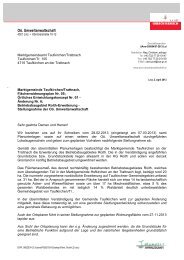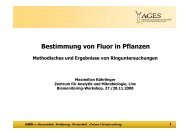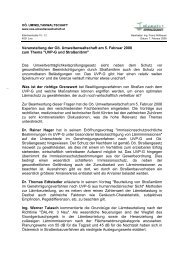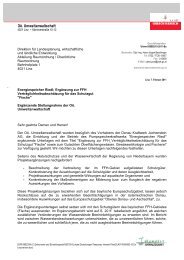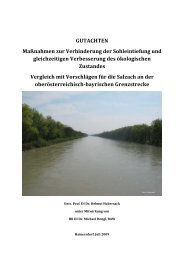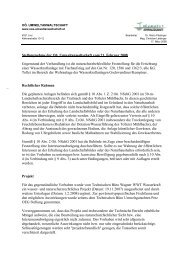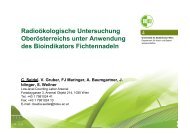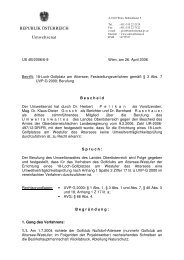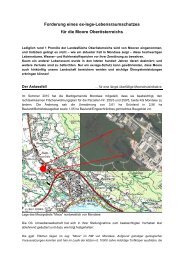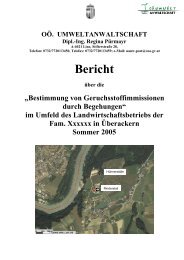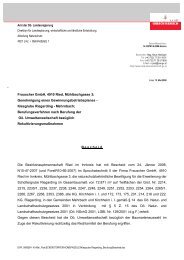1. Verkehr und Verkehrssicherheit (TG 01) - Oö. Umweltanwaltschaft
1. Verkehr und Verkehrssicherheit (TG 01) - Oö. Umweltanwaltschaft
1. Verkehr und Verkehrssicherheit (TG 01) - Oö. Umweltanwaltschaft
Erfolgreiche ePaper selbst erstellen
Machen Sie aus Ihren PDF Publikationen ein blätterbares Flipbook mit unserer einzigartigen Google optimierten e-Paper Software.
pronounced per g/m³ of NO 2 and increasing with decreasing particle size of PM in<br />
Graz, Linz and Vienna, indicate health effects of motor traffic. In all three cities NO2 is<br />
mainly of local origin, also in summer [36]."<br />
Als Schlussfolgerung daraus führen die Autoren u.a. an:<br />
"In Linz a very quick rise of cardiopulmonary emergencies was observed with NO 2 ,<br />
PM2.5 and PM10, even in summer (without heating) at levels below current standards.<br />
Together with the results on mortality this acute increase of cardiopulmonary morbidity<br />
indicates that urban air pollution is still a matter of concern and confirms the demand to lower<br />
PM2.5 standards and to introduce a limit value for the daily mean of PM2.5 in the European<br />
Union [33]."<br />
Die Schlussfolgerungen derselben Untersuchung in der On-Line-Kurzfassung der<br />
Fachpublikation "Extended effects of air pollution on cardiopulmonary mortality in Vienna" 4<br />
fassen die Problematik prägnant zusammen:<br />
"Results<br />
All three particulate measures and NO2 were associated with mortality from all causes and<br />
from ischemic heart disease and COPD at all ages and in the elderly. The magnitude of the<br />
effect was largest for PM2.5 and NO2. Best predictor of mortality increase lagged 0–7 days<br />
was PM2.5 (for ischemic heart disease and COPD) and NO2 (for other heart disease and all<br />
causes). Total mortality increase, lagged 0–14 days, per 10 g m3 was 2.6% for PM2.5 and<br />
2.9% for NO2, mainly due to cardiopulmonary and cerebrovascular causes.<br />
Conclusion<br />
Acute and subacute lethal effects of urban air pollution are predicted by PM2.5 and NO2<br />
increase even at relatively low levels of these pollutants. This is consistent with results on<br />
hospital admissions and the lack of a threshold. While harvesting (reduction of mortality after<br />
short increase due to premature deaths of most sensitive persons) seems to be of minor<br />
importance, deaths accumulate during 14 days after an increase of air pollutants. The limit<br />
values for PM2.5 and NO2 proposed for 2<strong>01</strong>0 in the European Union are unable to prevent<br />
serious health effects." 5<br />
Aus Sicht der <strong>Oö</strong>. <strong>Umweltanwaltschaft</strong> ist es daher erforderlich, die Humanmedizinische<br />
Bewertung (siehe oben aber auch siehe <strong>TG</strong> 13 S. 42) auf Basis dieser neueren Erkenntnisse<br />
zu überdenken <strong>und</strong> die Maßnahmen-Auflagen im Bereich Humanmedizin entsprechend<br />
abzuändern <strong>und</strong> nachzuschärfen. Die Aussage <strong>TG</strong> 13, S. 54 oben ("Alle im<br />
humanmedizinischen Teilgutachten erfolgten Schlussfolgerungen <strong>und</strong> Bewertungen sind<br />
ausschließlich im Zusammenhang mit diesen zusätzlichen Maßnahmen laut Teilgutachten<br />
Luftschadstoffe <strong>und</strong> Klima gültig.") kann so nicht stehen bleiben, da sie neueste<br />
humanmedizinische Erkenntnisse negiert.<br />
Unterstützt wird seitens der <strong>Oö</strong>. <strong>Umweltanwaltschaft</strong> die Aussage, dass aus medizinischer<br />
Sicht in der Bewertung kein Unterschied zwischen Wohnanrainern <strong>und</strong> Arbeitnehmers<br />
gemacht wird (<strong>TG</strong> 13, S. 40), da sich auch Arbeitnehmer bis zu 10-12 St<strong>und</strong>en im<br />
betroffenen Bereich aufhalten.<br />
4 Neuberger, M., D. Rabczenko <strong>und</strong> H. Moshammer (2<strong>01</strong>3): "Extended effects of air pollution on<br />
cardiopulmonary mortality in Vienna". In: Atmospheric Environment, Volume 41, Issue 38: 8549-8556,<br />
Dezember 2007.<br />
5 http://www.sciencedirect.com/science/article/pii/S1352231007006279 abgerufen am 03.10.2<strong>01</strong>3 um<br />
16:34 Uhr MEZ



